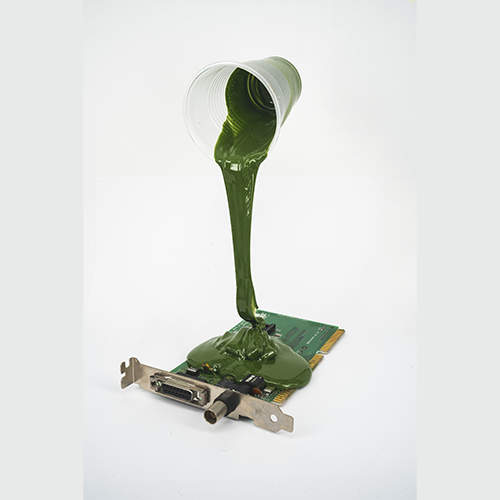ISO-PUR® K781
Resin with high hardness for mechanically and chemically stressed components
ISO-PUR® K781 is a mineral-filled, cold-curing 2-component polyurethane casting resin based on polyether and ester polyols as well as polymeric aromatic diisocyanates. After curing, the casting compound forms hard and tough, hydrolysis-stable moldings. These do not contain any plasticisers and do not tend to become brittle. ISO-PUR® K781 is particularly suitable for use in components subject to high mechanical and thermal stress. The system is characterised by good heat dissipation and little shrinkage during curing. The compound shows good corrosion protection properties and high adhesion to metal, ceramics and many plastics.

Area of application
Resin with high hardness for mechanically and chemically stressed components.
Technical data
Resin
Colour
Viscosity (25°C; rot.; 1 s-1)
Viscosity (25°C; rot.; 10 s-1)
Density (23°C)
Beige
Approx. 3000 mPas
Approx. 1700 mPas
Approx. 1,42 g/cm³
Hardener
Colour
Viscosity (25°C; rot.; 1 s-1)
Viscosity (25°C; rot.; 10 s-1)
Density (23°C)
Brown
Approx. 130 mPas
Approx. 120 mPas
Approx. 1,23 g/cm³
Mixture
Mixing ratio resin : hardener
Colour
2 : 1 parts by weight
Beige (other colours on request)
Density (23°C)
Approx. 1,35 g/cm³
Pot life (23°C)
Gel time (23°C)
Approx. 40 min
Approx. 80 min
Mixed viscosity (25°C; rot.; 1 s-1)
Mixed viscosity (25°C; rot.; 10 s-1)
Approx. 800 mPas
Approx. 700 mPas
Dielectric strength
> 8 kV/mm
Cured product
Mixing ratio resin: hardener
under standard curing condition
2 : 1 parts by weight
(14 days 23°C / 50% relative humidity) unless otherwise stated
Hardness Shore D
(23°C; 14d RT 50% rel. h.)
Hardness Shore D
(23°C; oven curing: 4hRT + 24h80°C)
Approx. 84
Approx. 84
Long-term temperature resistance
Short-term temperature resistance
Approx. 140°C
Approx. 200°C
Glass transition temperature (midset)
> 50°C
Tensile strength (5A specimen)
(2 mm thickness; speed: 10 mm/min; 23°C)
Elongation at break (5A specimen)
(2 mm thickness; speed: 10 mm/min; 23°C)
Approx. 58 N/mm2
Approx. 5%
Tear resistance
(W-specimen; incision; speed: 10 mm/min; 23°C)
Approx. 67 N/mm
Dielectric strength
> 22 kV/mm
Dielectric loss factor tan δ (25°C; 50 Hz)
Approx. 0,02
Dielectric constant ε (25°C; 50 Hz)
Approx. 4,10
Thermal conductivity
Approx. 0,30 W/K×m
Coefficient of thermal expansion
Approx. 50×10-6 K-1
Tracking resistance
KA 3c
Water absorption after 28 days
in water (immersion; 23°C)
Approx. 1,50%
Water vapour permeability
(75% relative humidity; 23°C; 1 mm thickness)
Approx. 1,90×10-5 g/(day×mm2)
Storage and transport
Store in a dry and airtight, closed container at 10 – 35°C. Can be stored for at least 12 months in original sealed containers under the above conditions. Short-term deviations during transport and storage are acceptable.
Cleaning
To ensure good adhesion of the cast resin the customer should individually test the suitability of the involved surfaces. Possible pre-treatments like cleaning, activation processes (plasma process) etc. should also be taken into account. The contact surfaces should be free of dirt such as dust, grease or water. For cleaning we recommend ISO-RC® Degreaser for wipe degreasing or ISO-RC® Flux-Off + ISO-RC® Spraywash for spray degreasing (available in 400 ml spray cans).
Processing
Stir up the resin container thoroughly before use to remove any possible sedimentation. Weigh the resin and hardener in the desired mixing ratio and mix for 1 – 3 minutes (depending on mixed quantity and processing time). Apply suitable mixing speed in order to ensure complete homogeneous mixing without introducing too many air bubbles into the reaction mass. The ideal processing temperature is 20 – 25°C. In general, curing is delayed at lower temperatures and accelerated at higher temperatures. When using a double chamber bag, empty the corners thoroughly and knead for 3 minutes. Before casting, a homogeneous mass, free of streaks, must be obtained. Pour immediately afterwards and do not scrape the mixing vessel. Air bubbles that have been stirred in, can be removed before the end of the potlife by evacuating the material or carefully fanning the surface with a hot air gun. Machine casting is also possible.
The EC safety data sheet provides information on safety-relevant product properties.
Hardener component (containing diisocyanate): As of August 24, 2023, appropriate training must be provided before industrial or commercial use.


